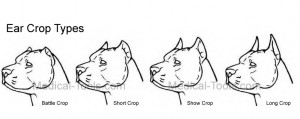Necessary for Pets?
Originally, ear cropping was done on “working” dogs such as terriers or hunting dogs, to save their ears from being injured while they were working. The practice of cropping ears has continued because many dog fanciers feel that the cropped ears complete the look of the dog. Many people are questioning the need for ear cropping: The aspect of animal cruelty comes into play, and many argue that there is no medical, physical, environmental or cosmetic advantage for the dog to have the pinnas (ear flaps) surgically altered. They claim to subject any dog to “disfiguring” and an unnecessary surgical procedure, subsequent taping, and bandaging after the surgery, amounts to animal cruelty and is indefensible.
Others will argue that for some breeds, the cropped ear will help prevent ear canal infections, and make the opportunity for ear infections much less likely. They will state the ear cropping is no different philosophically or ethically than surgery such as spaying, neutering, removing protruding dewclaws or tail docking. Today most veterinarians would agree that the incidence of ear infections in breeds with erect standing ears is far less than in breeds with droopy, pendulous ears.
Ear Cropping Breeds
Ear Cropping is performed on over 20 breeds of dogs, such as Doberman Pinschers, Great Danes, Boxers, Schnauzers, and Pit Bull Terriers. After surgery, there is an aftercare period. Ear cropping surgery is also performed on a variety of cats. Ear cropping in cats is done as a surgical treatment for cancers of the ear. Most dog owners opt to have this surgery for aesthetic reasons, the patient, fortunately, benefits from the additional medical benefits accompanying the surgery. In rare cases, ear cropping or similar types of surgeries are deemed medically necessary due to health conditions. Otherwise, the decision to crop ears is one made by the dog owner and/or breeder. Other common elective cosmetic procedures include tail docking and dewclaw removal.
The Ear Cropping Surgery
Ear cropping and corrective otoplasties are major surgical procedures and are as safe and as humane as any other elective surgical procedure when done correctly by an experienced, licensed veterinary surgeon in a hospital environment.
Ear Cropping Age
The surgery is performed at 8-12 weeks of age. Sometimes the surgery can be done at a later age, however, the chance of the ear successfully standing after surgery decreases with age. Even when performed at 12 weeks of age there is no guarantee that both ears will stand erect after surgery. Surgery only shapes the ear. Whether or not the ear stands up well has to do with the strength of the ear cartilage. At this age, the cartilage can usually be trained to stand erect.
After Ear Cropping
Ear cropping is a surgical procedure that involves precise cutting and shaping of the ear pinna (the floppy part of the ears) in order to make the ears stand erect. After surgery, the ears are bandaged and propped up so they heal in an erect position. Bandage changes are done weekly, and ears remain taped and propped up until they stand on their own. The healing process can take 4-8 weeks.
Ear Tapping
Important things to remember when taping the ear:
- Check for odors (The ears should not have a foul smell.)
- Keep the ears dry. If the ears get wet, rewrap them with dry tape.
- DO NOT take the ears down and let the ears “hang” for any length of time.
- If the ears fall — put them right back up in the roll.
Re-taping Your Puppy’s Ears yourself
learning to tape your puppy’s ears yourself will save you from having to pay the vet’s office to do it for you. It also helps your puppy become accustomed to being handled. Don’t worry if your first attempt is not as pretty as the vet can do it. You can always start over if you don’t think you’ve done a good job and, with just a little practice, you’ll get quite good at it. Another advantage of knowing how is that it can be done as often as you think it needs to be done (for example if the tape gets wet, soiled or ragged or if you wish to inspect the ears for healing progress or infection). Leave the tape on the first time about 3 days then remove it by carefully sliding a blunt ended pair of scissors between the edge of the ear and the tape then slowly peeling the tape from the ears.
Ear Crop Type
There are different lengths of ear crops:
- Military/Pet Crop: Ears are relatively short in length and have a wider base (bell). They do not typically take very long to stand.
- Medium Crop: Ears are a little longer and have a little less bell.
- Show Crop: Ears are longer and a little narrower than the other two crops.
- Long Crop: Ears are longe.
Ear Cropping Tools
Following tools are used for ear cropping, specially designed ear cropping clamps are used to hold the ears, these clamps function as surgical clamping guides and assist in producing beautiful, consistent ear crops. Breed Specific Kits are available to perform ear cropping, the kit includes all necessary tools to perform ear cropping.
Following Breed Specific Ear Cropping Kit are available.



